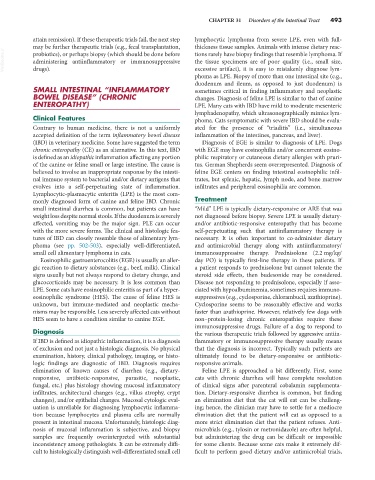Page 521 - Small Animal Internal Medicine, 6th Edition
P. 521
CHAPTER 31 Disorders of the Intestinal Tract 493
attain remission). If these therapeutic trials fail, the next step lymphocytic lymphoma from severe LPE, even with full-
may be further therapeutic trials (e.g., fecal transplantation, thickness tissue samples. Animals with intense dietary reac-
VetBooks.ir probiotics), or perhaps biopsy (which should be done before tions rarely have biopsy findings that resemble lymphoma. If
the tissue specimens are of poor quality (i.e., small size,
administering antiinflammatory or immunosuppressive
excessive artifact), it is easy to mistakenly diagnose lym-
drugs).
phoma as LPE. Biopsy of more than one intestinal site (e.g.,
duodenum and ileum, as opposed to just duodenum) is
SMALL INTESTINAL “INFLAMMATORY sometimes critical in finding inflammatory and neoplastic
BOWEL DISEASE” (CHRONIC changes. Diagnosis of feline LPE is similar to that of canine
ENTEROPATHY) LPE. Many cats with IBD have mild to moderate mesenteric
lymphadenopathy, which ultrasonographically mimics lym-
Clinical Features phoma. Cats symptomatic with severe IBD should be evalu-
Contrary to human medicine, there is not a uniformly ated for the presence of “triaditis” (i.e., simultaneous
accepted definition of the term inflammatory bowel disease inflammation of the intestines, pancreas, and liver).
(IBD) in veterinary medicine. Some have suggested the term Diagnosis of EGE is similar to diagnosis of LPE. Dogs
chronic enteropathy (CE) as an alternative. In this text, IBD with EGE may have eosinophilia and/or concurrent eosino-
is defined as an idiopathic inflammation affecting any portion philic respiratory or cutaneous dietary allergies with pruri-
of the canine or feline small or large intestine. The cause is tus. German Shepherds seem overrepresented. Diagnosis of
believed to involve an inappropriate response by the intesti- feline EGE centers on finding intestinal eosinophilic infil-
nal immune system to bacterial and/or dietary antigens that trates, but splenic, hepatic, lymph node, and bone marrow
evolves into a self-perpetuating state of inflammation. infiltrates and peripheral eosinophilia are common.
Lymphocytic-plasmacytic enteritis (LPE) is the most com-
monly diagnosed form of canine and feline IBD. Chronic Treatment
small intestinal diarrhea is common, but patients can have “Mild” LPE is typically dietary-responsive or ARE that was
weight loss despite normal stools. If the duodenum is severely not diagnosed before biopsy. Severe LPE is usually dietary-
affected, vomiting may be the major sign. PLE can occur and/or antibiotic-responsive enteropathy that has become
with the more severe forms. The clinical and histologic fea- self-perpetuating such that antiinflammatory therapy is
tures of IBD can closely resemble those of alimentary lym- necessary. It is often important to co-administer dietary
phoma (see pp. 502-503), especially well-differentiated, and antimicrobial therapy along with antiinflammatory/
small cell alimentary lymphoma in cats. immunosuppressive therapy. Prednisolone (2.2 mg/kg/
Eosinophilic gastroenterocolitis (EGE) is usually an aller- day PO) is typically first-line therapy in these patients. If
gic reaction to dietary substances (e.g., beef, milk). Clinical a patient responds to prednisolone but cannot tolerate the
signs usually but not always respond to dietary change, and steroid side effects, then budesonide may be considered.
glucocorticoids may be necessary. It is less common than Disease not responding to prednisolone, especially if asso-
LPE. Some cats have eosinophilic enteritis as part of a hyper- ciated with hypoalbuminemia, sometimes requires immuno-
eosinophilic syndrome (HES). The cause of feline HES is suppressives (e.g., cyclosporine, chlorambucil, azathioprine).
unknown, but immune-mediated and neoplastic mecha- Cyclosporine seems to be reasonably effective and works
nisms may be responsible. Less severely affected cats without faster than azathioprine. However, relatively few dogs with
HES seem to have a condition similar to canine EGE. non–protein-losing chronic enteropathies require these
immunosuppressive drugs. Failure of a dog to respond to
Diagnosis the various therapeutic trials followed by aggressive antiin-
If IBD is defined as idiopathic inflammation, it is a diagnosis flammatory or immunosuppressive therapy usually means
of exclusion and not just a histologic diagnosis. No physical that the diagnosis is incorrect. Typically such patients are
examination, history, clinical pathology, imaging, or histo- ultimately found to be dietary-responsive or antibiotic-
logic findings are diagnostic of IBD. Diagnosis requires responsive animals.
elimination of known causes of diarrhea (e.g., dietary- Feline LPE is approached a bit differently. First, some
responsive, antibiotic-responsive, parasitic, neoplastic, cats with chronic diarrhea will have complete resolution
fungal, etc.) plus histology showing mucosal inflammatory of clinical signs after parenteral cobalamin supplementa-
infiltrates, architectural changes (e.g., villus atrophy, crypt tion. Dietary-responsive diarrhea is common, but finding
changes), and/or epithelial changes. Mucosal cytologic eval- an elimination diet that the cat will eat can be challeng-
uation is unreliable for diagnosing lymphocytic inflamma- ing; hence, the clinician may have to settle for a mediocre
tion because lymphocytes and plasma cells are normally elimination diet that the patient will eat as opposed to a
present in intestinal mucosa. Unfortunately, histologic diag- more strict elimination diet that the patient refuses. Anti-
nosis of mucosal inflammation is subjective, and biopsy microbials (e.g., tylosin or metronidazole) are often helpful,
samples are frequently overinterpreted with substantial but administering the drug can be difficult or impossible
inconsistency among pathologists. It can be extremely diffi- for some clients. Because some cats make it extremely dif-
cult to histologically distinguish well-differentiated small cell ficult to perform good dietary and/or antimicrobial trials,

